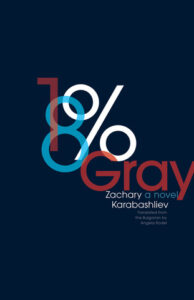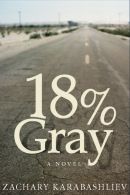When you take photos sometimes, you may know or not know that cameras have a light meter. All light meters including those in every camera must be calibrated to assume a certain percentage of light being reflected from the subject you want to photograph.
Each light meter can be used to determine correct exposure so long as the photographer knows the angle of measurement and knows how to isolate what is being measured. In addition to knowing the area from which the reading is taken, it is also important to know the approximate reflectance of that area. This is the part that can make using a reflected meter difficult, since the meter can’t determine subject reflectance for you and you must mentally calculate it.
Or you use a standardized surrogate subject such as the common Kodak Gray Card, which has a stated reflectance of 18%. Hence the title of this book, which has also a metaphorical meaning, as readers will find out.
Zack, the narrator/protagonist of this book – the fact that he has the same name as the author is a hint that probably a part of this novel is autobiographical – has two serious problems at the beginning of this book: Stella, his wife and the big love of his life has left him (and as we later learn: for good), and as a result of that Zack is in a severe crisis; and furthermore he comes unintentionally into possession of a big bag with marijuana.
What follows is a road trip from California to New York, and also a trip into the past of Zack’s and Stella’s lives. A man tries hard to find the woman he loves and whom he has lost (long before she physically left him); but he also tries to find again his vocation as an artist; and besides, he wants to sell the dope at the East Coast and maybe start a new life with the money.
The book is structured in a very interesting way: there is the story of Zack, after Stella left him, and his journey through the country; there are flashbacks that describe Stella’s and Zack’s story from the moment they met, in Varna, Bulgaria – by coincidence also a very important place in my life – , in the last days of the communist regime, their move to the U.S. as students, their attempts to build a new life – Stella as a painter, Zack as a photographer and after this fails, as a supervisor of test results for a pharmaceutical company -, and how their lives are drifting slowly apart; and there are short conversations between Zack and Stella, all recorded in moments when Zack takes photographs of Stella, and which give a clear indication of how their relationship slowly changes.
All three lines of this story have their own typography, so it is very easy for the reader to follow these permanent switches, which structure the texts into quite short sections. Here and also in the very good dialogues the reader feels that the author is also a prolific screen writer. This novel has a movie-like feel, and it is not surprising that it will be made (or is it already made?) into a movie.
The novel touches on many interesting topics: how do relationships change over time, and what can we do to prevent us from losing “it” – the love and also the purpose of life, which for Zack was first the music (when he was in Bulgaria, he started a career as front man of a punk band), later photography, and finally writing; it is also a novel about emigration and how it affects the identity of those who give up their home country and re-invent themselves somewhere else; it is a book about America (there are excellent descriptions not only about California and New York, but especially about the Mid West, Texas and all the other places Zack is crossing); can money really compensate us for other losses – the answer is obvious…; and a few more.
“I now realize that my American West was not a geographical place, but a sacred territory in my dreams. Perhaps everybody has their own Wild West. From a very young age, I knew with certainty that one day I would live in mine. I’d caress the yellow prairie grass and the wind would kiss my face. When did I lose all that? How did I manage to desecrate my West by replacing it with the plastic version of what I’ve been living in for the last few years of my life? “
I like about the book also that it is obviously in the tradition of the Künstlerroman (artist’s novel); but it reminds me at the same time of American road movies. There are plenty of absurd situations and people in the book, and also a kind of roguish humor which is a good antithesis to Zack’s and Stella’s sad story. I also like the somewhat ambiguous end and the wonderful last sentence:
“We watch the world outside through our reflections.”
A great book, if you ask me.
The English translation by Angela Rodel is flawless and excellent.
By the way, I read the English edition published by the Bulgarian publisher Ciela. For the cover they used a photo by the author (now editor-in-chief at the same publishing house) that fits this book very well.
PS: One – minor – correction: Old Firehand is of course NOT “a fictional native American hero” of several Karl May novels, as a footnote on page 190 informs us. “Hugh, ich habe gesprochen!”
Zachary Karabashliev: 18% Gray, transl. by Angela Rodel, Open Letter Books, Rochester 2013, Ciela, Sofia 2015
This review is part of Stu’s (Winstonsdad’s Blog) Eastern European Lit month: https://winstonsdad.wordpress.com/2015/03/02/welcome-to-eastern-european-lit-month/
© Thomas Hübner and mytwostotinki.com, 2014-5. Unauthorized use and/or duplication of this material without expressed and written permission from this blog’s author and/or owner is strictly prohibited. Excerpts and links may be used, provided that full and clear credit is given to Thomas Hübner and mytwostotinki.com with appropriate and specific direction to the original content.





 Facebook
Facebook RSS
RSS Twitter
Twitter
Pingback: An evening with books and writers | Mytwostotinki
Pingback: Bulgarian Literature Month – a few suggestions | Mytwostotinki